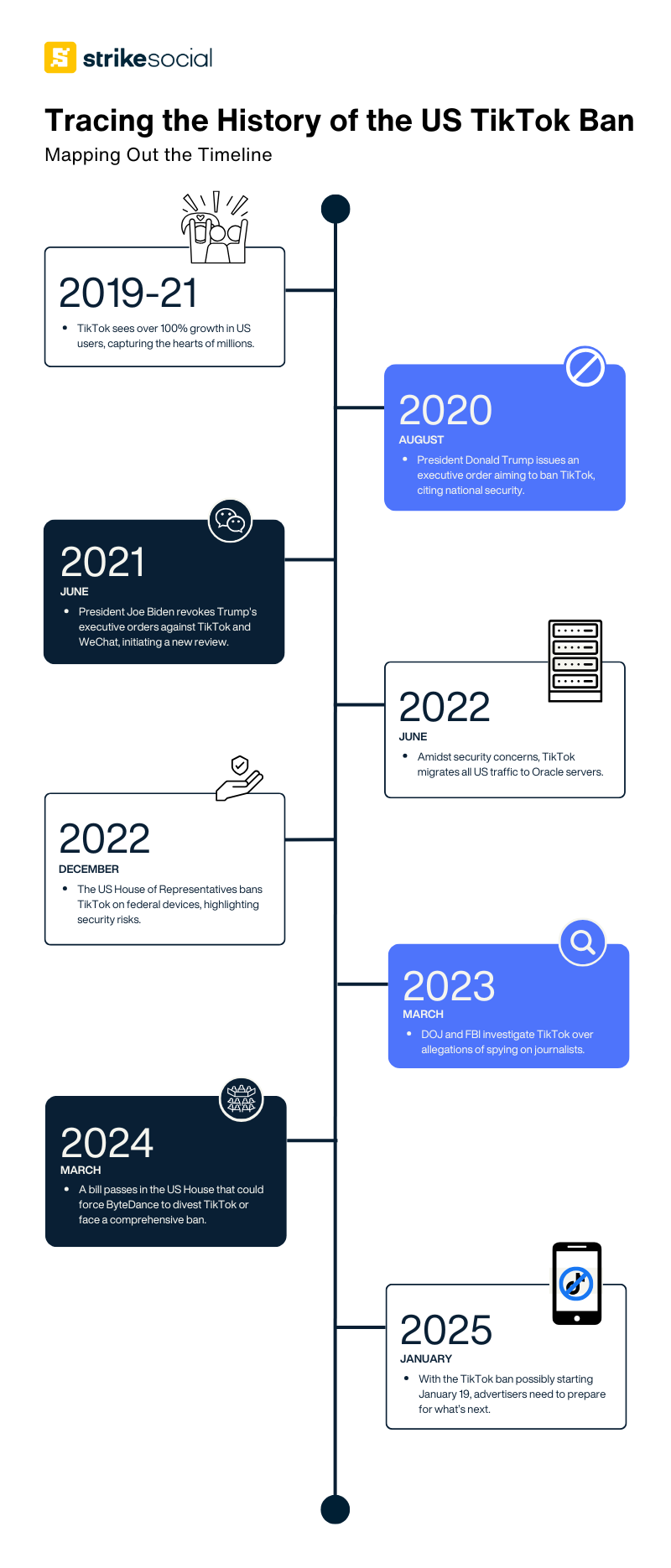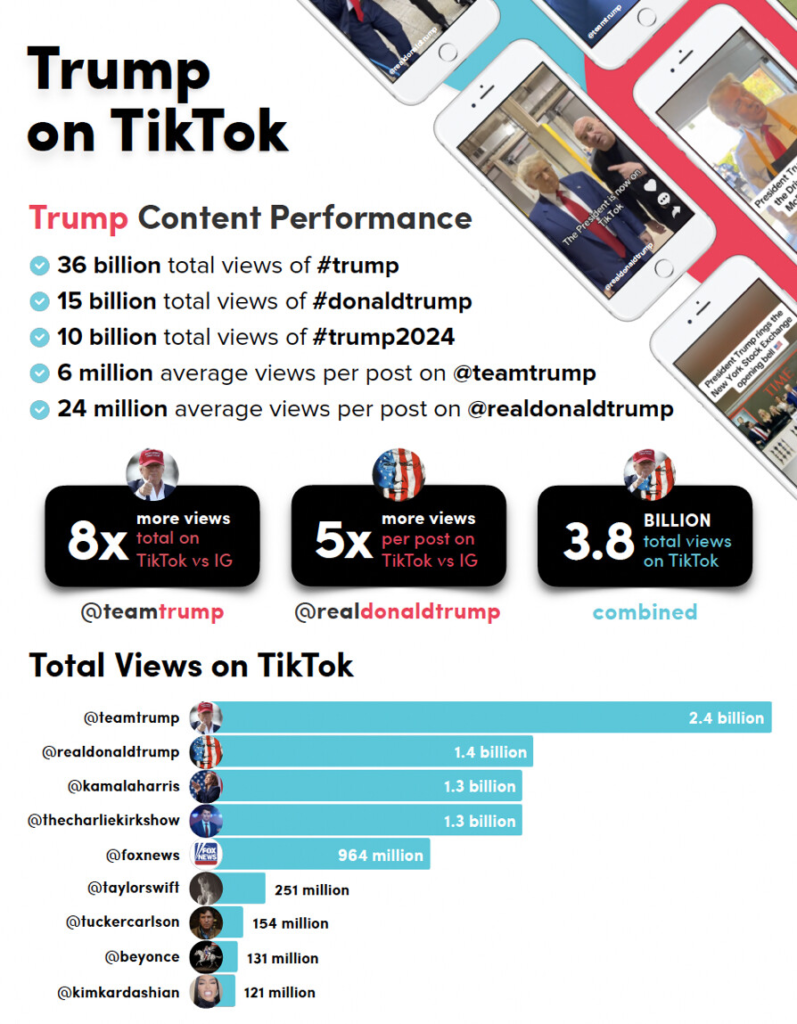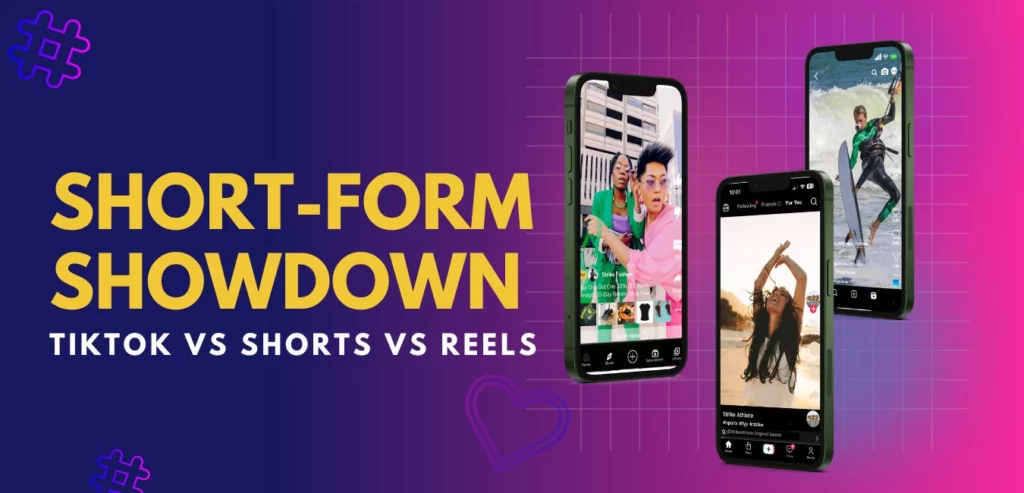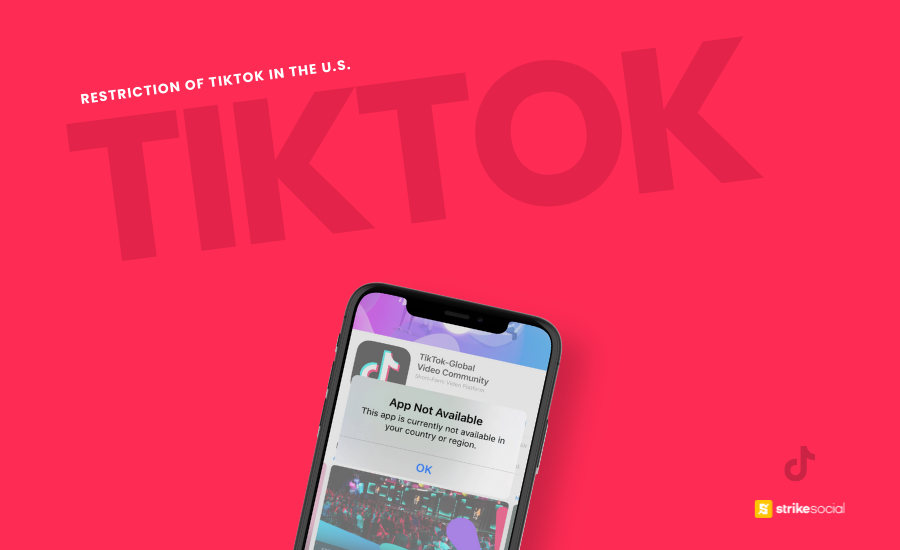Strike Overview
- The restriction of TikTok in the United States began in 2022 when President Joe Biden signed the No TikTok on Government Devices Act, prohibiting the app on federally owned devices.
- The motion gained momentum in 2024, fueled by concerns over ByteDance, the Chinese-owned company behind TikTok, CapCut, and other apps. If ByteDance fails to secure a U.S. buyer, the push for a complete ban on TikTok in the U.S. will likely persist.
- Based on the TikTok ban timeline, the app could become unavailable as early as January 19, 2025. With uncertainty looming, marketers must understand the implications and prepare for their next strategic move.
Jump to Section
Get exclusive content on paid social media.
Join our mailing list for the latest updates.

This post was updated in January 2025 to provide you with the latest information.
Restriction of TikTok in the United States & Marketers’ Next Move
The ticking clock on the restriction of TikTok in the United States grows louder each day. As US TikTok app users closer to the possibility of a ban, the platform’s vibrant community, encompassing a wide range of demographics, faces an uncertain future.
The concerns surrounding TikTok go beyond its user base, as marketers globally prepare for potential disruptions to advertising strategies and content creation if the full restriction of TikTok in the United States moves forward.
To fully grasp this complex debate, we must look back at TikTok’s evolution in the US. It’s a tale of transformation—from a hub for dance trends and viral skits to a focal point of national security discussions. Join us as we unpack the multifaceted narrative of the app’s ascent and the ensuing controversies that have led to increasing TikTok restrictions in the US.
See a snapshot of the pivotal moments that have shaped TikTok’s journey in the US, underscoring the app’s ascent and the controversies that have threatened its presence.
The evolving narrative around TikTok’s operational challenges in the US speaks a broader conversation about digital privacy, national security, and the future of international tech companies on American soil.
For marketers who have found efficacy and opportunity on the platform, the looming question is not just hypothetical but pressing: ‘What are the next steps after hearing the news about the restriction of TikTok in the United States?”

Why Panicking Shouldn’t Be On Your 2025 TikTok Advertising Strategy
The motion for TikTok restrictions in US has caused fear and panic among many users, creators, and advertisers. Headlines scream “Ban TikTok!” while social media feeds are flooded with speculation and lists of “Here’s what to do”. But before hitting the panic button, let’s take a deep breath and separate fact from fiction based on the recent news about the restrictions of TikTok in the United States.
Focusing on Facts Rather than Fear
Unfortunately, the uncertainty surrounding TikTok getting banned has become a breeding ground of confusion and baseless decisions. Here are some common anxieties we’ll discuss and give light:
Complete TikTok Ban Imminent
- While the US House has proposed a nationwide ban in 2024, the enactment could take effect by January 19, 2025. The situation is constantly evolving, with ongoing discussions and investigations. There’s still many discussions going on, such as TikTok appealing to President-elect Donald Trump, showing his stats from the last election and how TikTok views boosted him amongst other candidates.
- However, shall the full restrictions of TikTok in the United States take effect, this would impact not only the general public but also government devices and all government contracts. This includes personal devices used for federal contract work. To determine if your company is exempt from these restrictions, consider conducting an EPLS search.
Data Vanishing Act
- Users worried about losing all their data can find some solace here. Since June 2022, TikTok claims to have transferred US user data to Oracle servers in the US. However, skepticism persists regarding China’s potential data access.

Safekeeping Content
- Similar to having a window to access the data, even in a scenario when complete TikTok restrictions take place, users can download their data – photos, videos, and other content.
The Fall of the TikTok Influencer
- Geographical restrictions may not signal the end of influencer marketing fueled by TikTok Spark Ads.
- Many influencers and creators are already pivoting to alternative platforms and reshaping their strategies to cultivate fresh audiences from the ground up.
Further Reading

YouTube Shorts vs. Reels: What’s the Next Go-To Short-Form Platform
With a potential TikTok ban looming in the US, advertisers should keep their options open. Between YouTube Shorts and Instagram Reels, which short-form platform should you turn to next?
TikTok Community Adaptation
- If a ban happens, it’s unlikely to be immediate. The restriction of TikTok in the United States would give advertisers time to adjust their strategies and explore alternative platforms that might emerge to fill the gap.
- Businesses and creators should be ready to follow where the TikTok Nomads will eventually find their new home.
Short-Term Effects of Full TikTok Restrictions for U.S. Advertisers
Advertisers who have decided to stand still and tell their clients “Business As Usual” right after the news breaks out may reap their rewards.
Surge of Ad Costs on Other Short-Form Platforms
The ripple effect of TikTok restrictions in the US could catalyze a redistribution of ad budgets across paid social platforms.
Once ad money started to steer away from TikTok, advertisers might feel the tilt of price movement when comparing ad cost to other major short-form video platforms such as YouTube and Meta. This heightened activity might initially drive up ad costs.
Loyalty to TikTok May Still Pay Off
Moreover, the departure of brands who advertise on TikTok, anticipating a ban, opens up the floor for lower competition on the platform. This scenario creates a more open playing field for those who choose to stay, offering enhanced visibility and potentially higher engagement rates at lower costs.
Remember, the users did not leave the platform, and TikTok’s average time spent on the platform continues to rise. Isn’t that the land filled with milk and honey for the TikTok advertisers?
New Avenues to Discover when Diverting TikTok Ads
Lastly, the rise of emerging platforms in the wake of TikTok’s challenges could spotlight new advertising opportunities. These platforms will likely introduce innovative targeting options and deeper audience insights, offering fresh avenues to explore and capitalize on.
YouTube has developed its ad solutions by adding YouTube Shorts to its ad placements (Video Action Campaign, Video View Campaign, and Video Reach Campaign).
Further, Facebook is supercharging Reels by adding it to their sales-driven campaign objective, shopping ads.
How Do We React About The Restriction of TikTok in the United States
In today’s lens, the news of TikTok getting banned may seem like a hurdle, but it can also be an opportunity for growth and efficacy. Businesses that remain adaptable and embrace change will be well-positioned to thrive in the evolving digital landscape.
Advertisers should stay on their fingers about the latest developments surrounding the ban and potential timelines. From a long-term perspective, advertisers can prevent TikTok doom’s day by diversifying their marketing strategies by exploring alternative platforms and tailoring content to each platform’s specific audience and format. Remember, strong content that resonates with your target audience is the backbone of any successful digital marketing campaign, regardless of your chosen platform.
For short sprints of TikTok ad campaigns, media buyers may see efficiency once the room filled with buyers starts emptying some space due to moving ad money away from TikTok. Remaining proactive, creative, and data-driven, you can transform uncertainty into a springboard for success in the ever-changing world of digital marketing.
If you want to talk more about the possible effects and what to do next about the news around the restriction of TikTok in the United States, feel free to contact our Strike experts.








